性能提升1000+倍。
原理是使用df 代替du,
wget https://www.strongd.net/dl/hadoop-common-2.8.1.jar -C /usr/local/hadoop-2.8.1/share/hadoop/common/
wget https://www.strongd.net/dl/mydu -C /usr/bin/
chmod a+x /usr/bin/mydu
然后重启hadoop就可以了。
性能提升1000+倍。
原理是使用df 代替du,
wget https://www.strongd.net/dl/hadoop-common-2.8.1.jar -C /usr/local/hadoop-2.8.1/share/hadoop/common/
wget https://www.strongd.net/dl/mydu -C /usr/bin/
chmod a+x /usr/bin/mydu
然后重启hadoop就可以了。
Jenkins 是一个开源软件项目,是基于Java开发的一种持续集成工具,用于监控持续重复的工作,旨在提供一个开放易用的软件平台,使软件的持续集成变成可能。
首先我们需要准备 Java 环境,使用下面命令来安装 Java:
yum -y install java-1.8.0-openjdk-devel
为了使用 Jenkins 仓库,我们要执行以下命令:
sudo wget -O /etc/yum.repos.d/jenkins.repo https://pkg.jenkins.io/redhat-stable/jenkins.repo
sudo rpm --import https://pkg.jenkins.io/redhat-stable/jenkins.io.key
如果您以前从 Jenkins 导入过 key,那么 rpm --import 将失败,因为您已经有一个 key。请忽略,继续下面步骤。
接着我们可以使用 yum 安装 Jenkins:
yum -y install jenkins
任务时间:5min ~ 10min
启动 Jenkins 并设置为开机启动:
systemctl start jenkins.service
chkconfig jenkins on
Jenkins 默认运行在 8080端口。
稍等片刻,打开 http://<您的 CVM IP 地址>:8080 测试访问。
任务时间:5min ~ 10min
登入 Jenkins 需要输入管理员密码,按照提示,我们使用以下命令查看初始密码:
cat /var/lib/jenkins/secrets/initialAdminPassword
复制密码,填入,进入 Jenkins。
我们选择默认的 install suggested plugins 来安装插件。
请填入相应信息创建用户,然后即可登入 Jenkins 的世界。
恭喜,您已完成 搭建 Jenkins 环境搭建 实验。
云实验室云主机自动使用root账户登录系统,因此本教程中所有的操作都是以root用户来执行的。若要在自己的云主机上进行本教程的实验,为了系统安全,建议新建一个账户登录后再进行后续操作。
任务时间:1min ~ 5min
安装SSH:
sudo yum install openssh-clients openssh-server
安装完成后,可以使用下面命令进行测试:
ssh localhost
输入root账户的密码,如果可以正常登录,则说明SSH安装没有问题。测试正常后使用exit命令退出ssh。
任务时间:5min ~ 10min
使用yum来安装1.7版本OpenJDK:
sudo yum install java-1.7.0-openjdk java-1.7.0-openjdk-devel
安装完成后,输入java和javac命令,如果能输出对应的命令帮助,则表明jdk已正确安装。
执行命令:
编辑 ~/.bashrc,在结尾追加:
export JAVA_HOME=/usr/lib/jvm/java-1.7.0-openjdk
保存文件后执行下面命令使JAVA_HOME环境变量生效:
source ~/.bashrc
为了检测系统中JAVA环境是否已经正确配置并生效,可以分别执行下面命令:
java -version
$JAVA_HOME/bin/java -version
若两条命令输出的结果一致,且都为我们前面安装的openjdk-1.7.0的版本,则表明JDK环境已经正确安装并配置。
任务时间:10min ~ 15min
本教程使用hadoop-2.7版本,使用wget工具在线下载(注:本教程是从清华大学的镜像源下载,如果下载失败或报错,可以自己在网上找到国内其他一个镜像源下载2.7版本的hadoop即可):
wget https://mirrors.tuna.tsinghua.edu.cn/apache/hadoop/common/hadoop-2.7.4/hadoop-2.7.4.tar.gz
将Hadoop安装到/usr/local目录下:
tar -zxf hadoop-2.7.4.tar.gz -C /usr/local
对安装的目录进行重命名,便于后续操作方便:
cd /usr/local
mv ./hadoop-2.7.4/ ./hadoop
检查Hadoop是否已经正确安装:
/usr/local/hadoop/bin/hadoop version
如果成功输出hadoop的版本信息,表明hadoop已经成功安装。
任务时间:15min ~ 30min
Hadoop伪分布式模式使用多个守护线程模拟分布的伪分布运行模式。
编辑 ~/.bashrc,在结尾追加如下内容:
export HADOOP_HOME=/usr/local/hadoop
export HADOOP_INSTALL=$HADOOP_HOME
export HADOOP_MAPRED_HOME=$HADOOP_HOME
export HADOOP_COMMON_HOME=$HADOOP_HOME
export HADOOP_HDFS_HOME=$HADOOP_HOME
export YARN_HOME=$HADOOP_HOME
export HADOOP_COMMON_LIB_NATIVE_DIR=$HADOOP_HOME/lib/native
export PATH=$PATH:$HADOOP_HOME/sbin:$HADOOP_HOME/bin
使Hadoop环境变量配置生效:
source ~/.bashrc
Hadoop的配置文件位于安装目录的/etc/hadoop目录下,在本教程中即位于/url/local/hadoop/etc/hadoop目录下,需要修改的配置文件为如下两个:
/usr/local/hadoop/etc/hadoop/core-site.xml
/usr/local/hadoop/etc/hadoop/hdfs-site.xml
编辑 core-site.xml,修改<configuration></configuration>节点的内容为如下所示:
<configuration>
<property>
<name>hadoop.tmp.dir</name>
<value>file:/usr/local/hadoop/tmp</value>
<description>location to store temporary files</description>
</property>
<property>
<name>fs.defaultFS</name>
<value>hdfs://localhost:9000</value>
</property>
</configuration>
同理,编辑 hdfs-site.xml,修改<configuration></configuration>节点的内容为如下所示:
<configuration>
<property>
<name>dfs.replication</name>
<value>1</value>
</property>
<property>
<name>dfs.namenode.name.dir</name>
<value>file:/usr/local/hadoop/tmp/dfs/name</value>
</property>
<property>
<name>dfs.datanode.data.dir</name>
<value>file:/usr/local/hadoop/tmp/dfs/data</value>
</property>
</configuration>
格式化NameNode:
/usr/local/hadoop/bin/hdfs namenode -format
在输出信息中看到如下信息,则表示格式化成功:
Storage directory /usr/local/hadoop/tmp/dfs/name has been successfully formatted.
Exiting with status 0
启动NameNode和DataNode进程:
/usr/local/hadoop/sbin/start-dfs.sh
执行过程中会提示输入用户密码,输入root用户密码即可。另外,启动时ssh会显示警告提示是否继续连接,输入yes即可。
检查 NameNode 和 DataNode 是否正常启动:
jps
如果NameNode和DataNode已经正常启动,会显示NameNode、DataNode和SecondaryNameNode的进程信息:
[hadoop@VM_80_152_centos ~]$ jps
3689 SecondaryNameNode
3520 DataNode
3800 Jps
3393 NameNode
任务时间:10min ~ 20min
Hadoop自带了丰富的例子,包括 wordcount、grep、sort 等。下面我们将以grep例子为教程,输入一批文件,从中筛选出符合正则表达式dfs[a-z.]+的单词并统计出现的次数。
Hadoop 附带了丰富的例子, 执行下面命令可以查看:
cd /usr/local/hadoop
./bin/hadoop jar ./share/hadoop/mapreduce/hadoop-mapreduce-examples-2.7.4.jar
在 HDFS 中创建用户目录 hadoop:
/usr/local/hadoop/bin/hdfs dfs -mkdir -p /user/hadoop
本教程中,我们将以 Hadoop 所有的 xml 配置文件作为输入数据来完成实验。执行下面命令在 HDFS 中新建一个 input 文件夹并将 hadoop 配置文件上传到该文件夹下:
cd /usr/local/hadoop
./bin/hdfs dfs -mkdir /user/hadoop/input
./bin/hdfs dfs -put ./etc/hadoop/*.xml /user/hadoop/input
使用下面命令可以查看刚刚上传到 HDFS 的文件:
/usr/local/hadoop/bin/hdfs dfs -ls /user/hadoop/input
运行实验:
cd /usr/local/hadoop
./bin/hadoop jar ./share/hadoop/mapreduce/hadoop-mapreduce-examples-2.7.4.jar grep /user/hadoop/input /user/hadoop/output 'dfs[a-z.]+'
上述命令以 HDFS 文件系统中的 input 为输入数据来运行 Hadoop 自带的 grep 程序,提取其中符合正则表达式 dfs[a-z.]+ 的数据并进行次数统计,将结果输出到 HDFS 文件系统的 output 文件夹下。
上述例子完成后的结果保存在 HDFS 中,通过下面命令查看结果:
/usr/local/hadoop/bin/hdfs dfs -cat /user/hadoop/output/*
如果运行成功,可以看到如下结果:
1 dfsadmin
1 dfs.replication
1 dfs.namenode.name.dir
1 dfs.datanode.data.dir
删除 HDFS 中的结果目录:
/usr/local/hadoop/bin/hdfs dfs -rm -r /user/hadoop/output
运行 Hadoop 程序时,为了防止覆盖结果,程序指定的输出目录不能存在,否则会提示错误,因此在下次运行前需要先删除输出目录。
关闭 Hadoop 进程:
/usr/local/hadoop/sbin/stop-dfs.sh
再起启动只需要执行下面命令:
/usr/local/hadoop/sbin/start-dfs.sh
任务时间:时间未知
恭喜您已经完成了搭建 Hadoop 伪分布式环境的学习
A few weeks ago I got to make some of my code 1000 times faster, without changing the underlying complexity! As the title implies, this involved making Java reflection calls faster.
Let me explain my use case as well, because it’s relatively general, and a good example of why one would use reflection in the first place.
I had an interface (representing a tree node) and a slew of classes (100+) implementing this interface. The trick is that the tree is heterogeneous, each node kind can have different numbers of children, or store them differently.
I needed some code te be able to walk over such a composite tree. The simple approach is to simply add a children() method to the interface and implement it in every kind of node. Very tedious, and boilerplaty as hell.
Instead, I noted that all children were either direct fields, or aggregated in fields holding a collection of nodes. I could write a small piece of code that, with reflection, would work for every node kind!
I’ve put up a much simplified version of the code on Github. I will link the relevant parts as we go.
Here is the version I came up with: WalkerDemoSlowest.java
It’s fairly straightforward: get the methods of the node’s class, filter out those that are not getters, then consider only that return either a node or a collection of node. For those, invoke the method, and recursively invoke walk on the children.
Will anyone be surprised if I tell them it’s very slow?
There is a simple tweak we can apply that makes it much faster however: we can cache the methods lookup.
Here is the caching version: WalkerDemoSlow.java
It’s really the same except that for each class implementing Node, we create aClassData object that caches all the relevant getters, so we only have to look them up once. This produces a satisfying ~10x speedup.
Unfortunately, this was still way too slow. So I took to Google, which turned out this helpful StackOverflow question.
The accepted answers proposes the use of LambdaMetafactory, a standard library class that supports lambda invocations in the language.
The details are somewhat hazy to me, but it seems that by using these facilities we can “summon the compiler” on our code and optimize the reflective access into a native invocation. That’s the working hypothesis anyhow.
Here is the code: WalkerDemoFast.java
Now, in my code, this worked wonders, unlocking another 100x speedup. While writing this article however, I wanted to demonstrate the effect with some code snippet, but didn’t manage to. I tried to give the interface three sub-classes, and to give them bogus methods to be filtered out, to no avail. The second and third version of the code would run at about the same speed.
I re-checked the original code — all seemed good. In my original code, the trees are Abstract Syntax Trees (AST) derived by parsing some source files. After fooling around some more, I noticed different results if I limited the input to the first 14 source files.
These files are relatively short (few 10s of lines) and syntactically simple. With only those, the second and third version would run at about the same speed. But add in the 15th file (a few 100s of lines) and the second version would take a whopping 36 seconds while the third version would still complete in 0.2 seconds, a ~700x difference.
My (somewhat shaky) hypothesis is that if the scenario is simple enough, the optimizer notices what you are doing and optmizes away. In more complex cases, it exhausts its optimization budget and falls back on the unoptimized version and its abysmal performance. But the optimizer is devious enough that crafting a toy example that would defeat it seems to be quite the feat.
I’m somewhat intrigued about what is possible with LambdaMetafactory. In my use case, it works wonders because reflection calls are much more expensive than a simple cache lookup. But could it be used to optmize regular code in pathological cases as well? It seems unlikely to help with megamorphic call sites, because the compiled method handle has to be retrieved somehow, and the cost of that lookup would dwarf the gains.
But what about piecing together code at run time, and optimizing it? In particular, one could supply a data structure and an interpreter for that data structure, and “compile” them together using LambdaMetafactory. Would it be smart enough to partially evaluate the code given the data structure, and so turn your interpreter into the equivalent “plain” code?
Incidentally, that is exactly the approach taken by the Truffle framework, which runs on top of the Graal VM, so there is definitely something to the idea. Maybe something precludes it with the current JVM, hence requiring the GraalVM modification?
In any case, there is something to be said in favor of making these capabilities available as a library, which could be used in “regular programs” (i.e. not compilers). Writing a simple interpreter is often the easiest approach to some problems.
使用hbase的目的是为了海量数据的随机读写,但是在实际使用中却发现针对随机读的优化和gc是一个很大的问题,而且hbase的数据是存储在Hdfs,而Hdfs是面向流失数据访问进行设计的,就难免带来效率的下降。下面介绍一下Facebook Message系统在HBase online storage场景下的一个案例(《Apache Hadoop Goes Realtime at Facebook》, SIGMOD 2011),最近他们在存储领域顶级会议FAST2014上发表了一篇论文《Analysis of HDFS Under HBase: A Facebook Messages Case Study》分析了他们在使用HBase中遇到的一些问题和解决方案。该论文首先讲了Facebook的分析方法包括tracing/analysis/simulation,FM系统的架构和文件与数据构成等,接下来开始分析FM系统在性能方面的一些问题,并提出了解决方案。
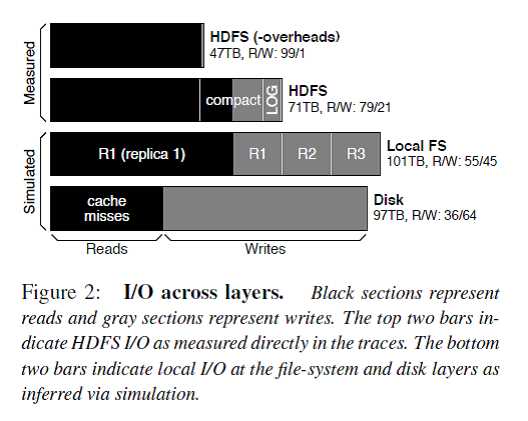
Figure 2描述了每一层的I/O构成,解释了在FM系统对外请求中读占主导,但是由于logging/compaction/replication/caching导致写被严重放大。

总的来说,HBase stack的logging/compaction/replication/caching会放大写I/O,导致业务逻辑上读为主导的HBase系统在地层实际磁盘I/O中写占据了主导。
FM系统的主要文件类型和大小
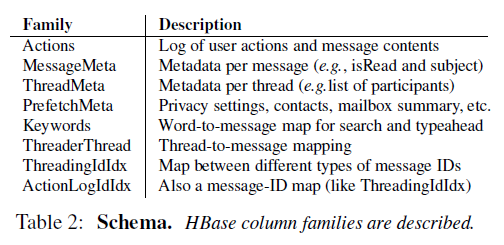
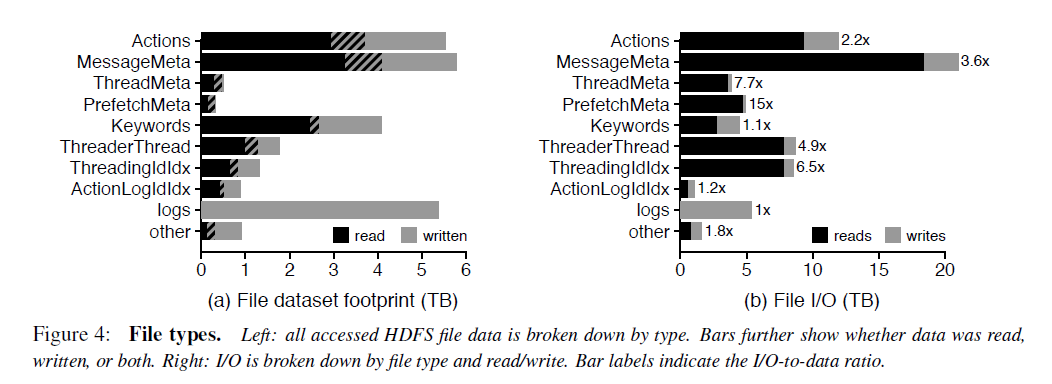
对于每个column family的文件,90%是小于15M的。但是少量的特别大的文件会拉高column family的平均文件大小。例如MessageMeta这个column family的平均文件大小是293M。从这些文件的生命周期来看,大部分FM的数据存储在large,long-lived files,然而大部分文件却是small, short-lived。这对HDFS的NameNode提出了很大的挑战,因为HDFS设计的初衷是为了存储少量、大文件准备的,所有的文件的元数据是存储在NameNode的内存中的,还有有NameNode federation。
FM系统的主要I/O访问类型
下面从temporal locality, spatial locality, sequentiality的角度来看。
73.7%的数据只被读取了一次,但是1.1%的数据被读取了至少64次。也就是说只有少部分的数据被重复读取了。但是从触发I/O的角度,只有19%的读操作读取的是只被读取一次的数据,而大部分I/O是读取那些热数据。
在HDFS这一层,FM读取数据没有表现出sequentiality,也就是说明high-bandwidth, high-latency的机械磁盘不是服务读请求的理想存储介质。而且对数据的读取也没有表现出spatial locality,也就是说I/O预读取也没啥作用。
解决方案1. Flash/SSD作为cache使用
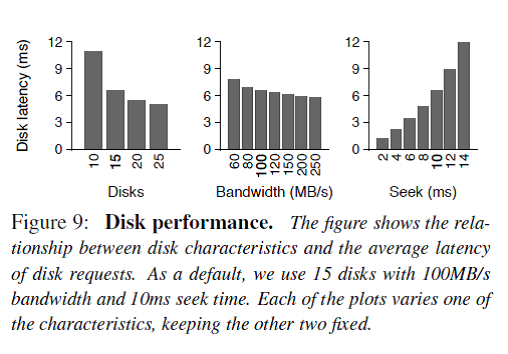
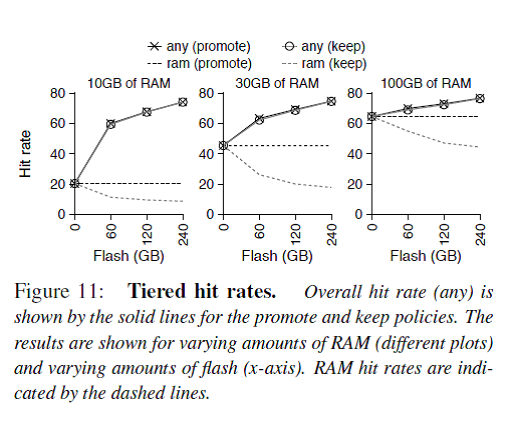
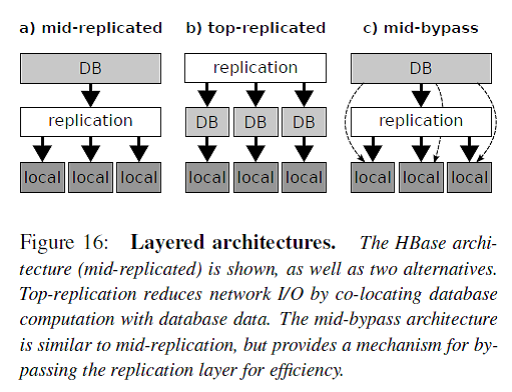
如Figure 16所示,一般分布式数据库系统分为三个层次:db layer/replication layer/local layer。这种分层架构的最大优点是简洁清晰,每层各司其职。例如db layer只需要处理DB相关的逻辑,底层的存储认为是available和reliable的。
HBase是图中a)的架构,数据的冗余replication由HDFS来负责。但是这个带来一个问题就是例如compaction操作会读取多个三备份的小文件到内存merge-sorting成一个三备份的大文件,这个操作只能在其中的一个RS/DN上完成,那么从其他RS/DN上的数据读写都会带来网络传输I/O。
图中b)的架构就是把replication层放到了DB层的上面,Facebook举的例子是Salus,不过我对这个东西不太熟悉。我认为Cassandra就是这个架构的。这个架构的缺点就是DB层需要处理底层文件系统的问题,还要保证和其他节点的DB层协调一致,太复杂了。
图中c)的架构是在a的基础上的一种改进,Spark使用的就是这个架构。HBase的compaction操作就可以简化成join和sort这样两个RDD变换。
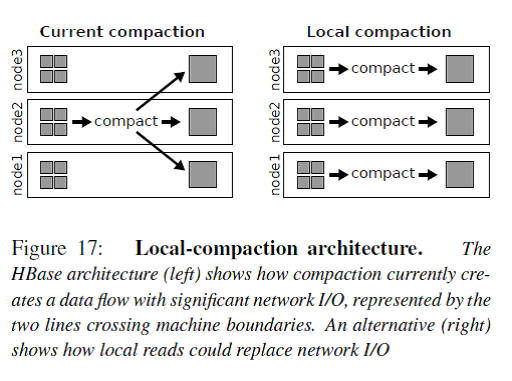
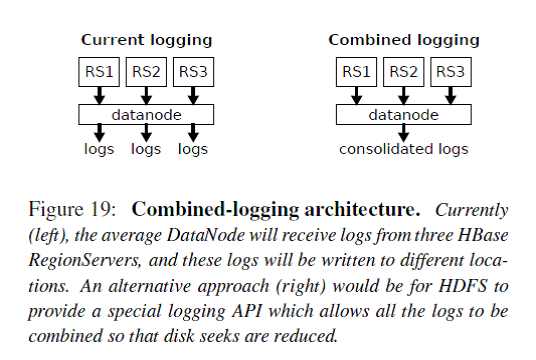
Recognize and manipulate faces from Python or from the command line with the world’s simplest face recognition library.
Built using dlib‘s state-of-the-art face recognition built with deep learning. The model has an accuracy of 99.38% on theLabeled Faces in the Wild benchmark.
This also provides a simple face_recognition command line tool that lets you do face recognition on a folder of images from the command line!
Find all the faces that appear in a picture:
Project site : https://github.com/ageitgey/face_recognition
本脚本适用环境:
系统支持:CentOS6+,Debian7+,Ubuntu12+
内存要求:≥128M
更新日期:2017 年 05 月 28 日
关于本脚本:
名词解释如下
L2TP(Layer 2 Tunneling Protocol)
IPSec(Internet Protocol Security)
IKEv2 (Internet Key Exchange v2)
能实现 IPsec 的目前总体上有 openswan,libreswan,strongswan 这3种。
libreswan 是基于 openswan 的 fork,所以现在各个发行版基本已经看不到 openswan 的身影了。
当然也有使用 strongswan 的。
之所以要更新 L2TP 一键安装脚本,是因为随着各个 Linux 发行版不断推陈出新,原有的脚本已经不适应现在的需求。
本脚本通过编译安装最新版 libreswan 来实现 IPSec(CentOS7 下则是全部 yum 安装),yum 或 apt-get 来安装 xl2tpd,再根据各个发行版的使用方法不同,部署防火墙规则。
基于 OpenVZ 虚拟化技术的 VPS 需要开启TUN/TAP才能正常使用,购买 VPS 时请先咨询服务商是否支持开启 TUN/TAP。
OpenVZ 虚拟的 VPS 需要系统内核支持 IPSec 才行。也就是说,母服务器的内核如果不支持的话那就没办法,只能换 VPS。
因此,一般不建议在 OpenVZ 的 VPS 上安装本脚本。脚本如果检测到该 VPS 为 OpenVZ 架构,会出现警告提醒。
如何检测是否支持TUN模块?
执行命令:
cat /dev/net/tun
如果返回信息为:cat: /dev/net/tun: File descriptor in bad state 说明正常
如何检测是否支持ppp模块?
执行命令:
cat /dev/ppp
如果返回信息为:cat: /dev/ppp: No such device or address 说明正常
当然,脚本在安装时也会执行检查,如果不适用于安装,脚本会予以提示。
root 用户登录后,运行以下命令:
wget --no-check-certificate https://raw.githubusercontent.com/teddysun/across/master/l2tp.sh chmod +x l2tp.sh ./l2tp.sh
执行后,会有如下交互界面
Please input IP-Range:
(Default Range: 192.168.18):
输入本地IP段范围(本地电脑连接到VPS后给分配的一个本地IP地址),直接回车意味着输入默认值192.168.18
Please input PSK:
(Default PSK: teddysun.com):
PSK意为预共享密钥,即指定一个密钥将来在连接时需要用到,直接回车意味着输入默认值teddysun.com
Please input Username:
(Default Username: teddysun):
Username意为用户名,即第一个默认用户。直接回车意味着输入默认值teddysun
Please input teddysun’s password:
(Default Password: Q4SKhu2EXQ):
输入用户的密码,默认会随机生成一个10位包含大小写字母和数字的密码,当然你也可以指定密码。
ServerIP:your_server_main_IP
显示你的 VPS 的主 IP(如果是多 IP 的 VPS 也只显示一个)
Server Local IP:192.168.18.1
显示你的 VPS 的本地 IP(默认即可)
Client Remote IP Range:192.168.18.2-192.168.18.254
显示 IP 段范围
PSK:teddysun.com
显示 PSK
Press any key to start…or Press Ctrl+c to cancel
按下任意按键继续,如果想取消安装,请按Ctrl+c键
安装完成后,脚本会执行 ipsec verify 命令并提示如下:
If there are no [FAILED] above, then you can connect to your L2TP VPN Server with the default Username/Password is below: ServerIP:your_server_IP PSK:your PSK Username:your usename Password:your password If you want to modify user settings, please use command(s): l2tp -a (Add a user) l2tp -d (Delete a user) l2tp -l (List all users) l2tp -m (Modify a user password) Welcome to visit https://teddysun.com/448.html Enjoy it!
如果你要想对用户进行操作,可以使用如下命令:
l2tp -a 新增用户
l2tp -d 删除用户
l2tp -m 修改现有的用户的密码
l2tp -l 列出所有用户名和密码
l2tp -h 列出帮助信息
1、脚本在安装完成后,已自动启动进程,并加入了开机自启动。
2、脚本会改写 iptables 或 firewalld 的规则。
3、脚本安装时,会即时将安装日志写到 /root/l2tp.log 文件里,如果你安装失败,可以通过此文件来寻找错误信息。
ipsec status (查看 IPSec 运行状态)
ipsec verify (查看 IPSec 检查结果)
/etc/init.d/ipsec start|stop|restart|status (CentOS6 下使用)
/etc/init.d/xl2tpd start|stop|restart (CentOS6 下使用)
systemctl start|stop|restart|status ipsec (CentOS7 下使用)
systemctl start|stop|restart xl2tpd (CentOS7 下使用)
service ipsec start|stop|restart|status (Debian/Ubuntu 下使用)
service xl2tpd start|stop|restart (Debian/Ubuntu 下使用)
2017 年 05 月 28 日:
升级 libreswan 到版本 3.20。
修正 libreswan 的若干配置问题。
修正 xl2tpd 的端口监听配置问题。
修正在 CentOS 6 对 libevent2 的依赖问题,改为 yum 安装 libevent2-devel。
测试表明,在内网环境的 VPS 里(如AWS, IDCF,GCE,腾讯云,阿里云等)也可以正常使用了。
2017 年 02 月 25 日:
升级 libreswan 到版本 3.19。
2016 年 09 月 12 日:
修正了在 CentOS 6 下 libevent2 依赖的问题;
新增了一个 -m 选项,用以修改现有用户的密码。
2016 年 08 月 13 日:
修正 Debian 8 下的 sd-daemon.h: No such file or directory 问题,是由于缺少依赖包 libsystemd-daemon-dev 导致的。
2016 年 08 月 05 日:
升级 libreswan 到版本 3.18。
2016 年 06 月 10 日:
脚本在安装完成后,新增了几个命令,便于操作用户
l2tp -a 新增用户
l2tp -d 删除用户
l2tp -l 列出所有用户
l2tp -h 列出帮助信息
2016 年 04 月 25 日:
4、在 Vultr 的 Debian 7的系统模板下安装时,软件包 libcurl4-nss-dev 会出现依赖错误。如下所示:
The following packages have unmet dependencies: libcurl4-nss-dev : Depends: libldap2-dev but it is not going to be installed Depends: librtmp-dev but it is not going to be installed
而 libldap2-dev 和 librtmp-dev 又依赖了其他几种软件包。总之最后的依赖关系如下:
libldap2-dev : Depends: libldap-2.4-2 (= 2.4.31-2+deb7u1) but 2.4.31+really2.4.40+dfsg-1+deb8u1~bpo70+1 is to be installed librtmp-dev : Depends: libgnutls-dev but it is not going to be installed libgnutls-dev : Depends: libp11-kit-dev (>= 0.4) but it is not going to be installed libp11-kit-dev : Depends: libp11-kit0 (= 0.12-3) but 0.20.7-1~bpo70+1 is to be installed
那么解决办法就是把最底层的依赖包 libp11-kit0 先卸载掉,然后再安装 libcurl4-nss-dev 即可。
apt-get -y remove libp11-kit0 apt-get -y --no-install-recommends install libcurl4-nss-dev wget
然后再运行脚本安装即可。
2016 年 04 月 22 日:
修复了在 Ubuntu 16.04 下因为默认缺少 python 命令而导致 ipsec verify 等命令不能用的问题。
2016 年 04 月 19 日:
修复了在 Debian 7 下因为 libnss3 和 libnspr4 的版本过低而导致编译 libreswan 失败的问题。
2016 年 04 月 18 日:
目前在 Debian 7 上测试的结果,因为 libnss3 和 libnspr4 的版本过低而导致编译 libreswan 失败。临时解决办法是 dpkg 安装 libnss3_3.17.2 和 libnspr4_4.10.7 的 deb 包后重试。
参考链接:
https://libreswan.org/wiki/3.14_on_Debian_Wheezy
https://github.com/libreswan/libreswan
转载请注明:秋水逸冰 » L2TP/IPSec一键安装脚本

Our mission at Tutorialzine is to keep you up to date with the latest and coolest trends in web development. That’s why every month we release a handpicked collection of some of the best resources that we’ve stumbled upon and deemed worthy of your attention.
A set of beautiful SVG icons with very detailed on-hover animations. Unlike most other web icon fonts, this one is actually JavaScript-powered and requires the bodymovin library for exporting After Effects animations to SVG format.
Rebass is a React UI kit for building responsive web apps. It is made up of over 60 styled-components which are customizable via styled-system-based properties. This keeps styles isolated and reduces the need to write custom CSS.
Bootstrap 4 is now officially in Beta! The new version of the framework brings forth a lot of great changes, including a flexbox-based grid system, new and restyled components, faster ES6 JavaScript plugins, improved documentation, and much more.
A cool set of HTML buttons with animated on-hover effects. The buttons come in all shapes and sizes and there are a lot of great animations to choose from. The library is made with SCSS so you can easily remove the buttons you don’t need or change the styles to your liking.
React components library for creating maps made out of SVG. There are components for adding all kinds of map details like text annotations, markers, and custom colors for each region. Since the maps are SVG based they can be zoomed in and out with great efficiency.
Library for running browser JavaScript code in the GPU. It allows you to execute complex calculations much quicker by compiling specially written JS into shader language that can run on the GPU via WebGL. If WebGL isn’t available the functions fallback to regular JavaScript.
Pell is a super lightweight WYSIWYG text editor for the web. It weights only 1kB, has absolutely no dependencies, and is made up of less than 200 lines of ES6 code. It supports all the needed actions for formatting markdown text, including inserting images and links.
Web automation framework based on the Headless Chrome platform. Its API and features are very similar to those of other popular tools like PhantomJS and NightmareJS, with the main difference that it runs all test in Chrome’s headless-mode. Work locally or on AWS Lambda.
Fitty is a vanilla JavaScript library that changes the font size of text to make it fit into a fixed-width container. It works with all standard web fonts, scaling their size up or down so that they optimally take the available space without line breaks – perfect for titles and other headings.
A Node.js library for sending notifications. It works as an all-in-one solution for handling emails, SMS, and push notifications. Each service has multiple providers you can choose from (e.g. SMPT or Sendmail for email, Neximo or Twilio for SMS).
Shoelace is a super lightweight CSS starter kit that aims to provide a tinier alternative to frameworks like Bootstrap. It doesn’t have too many styles and features, just a solid CSS reset with some helpful UI components. The library’s code is built with CSS variables, making it easy to customize without the need of a preprocessor.
Framework for running neural networks in the browser. TensorFire is GPU-accelerated via WebGL, which makes it possible to run bigger machine learning models without a problem. The project is still in its early stages but there are already some very promising demos made with it (Gesture Detection Rock Paper Scissors).
Admin dashboard template built with Bootstrap, PugJS, Sass, and other modern technologies. Because the project is created with easy customization in mind, all the styles are organized into many independent SASS modules. The template offers many components and widgets, you can check them out in this demo.
A JavaScript framework for building conversational bot interfaces. It has a super simple API that lets you configure the flow of conversations by adding messages, questions, and even form inputs fields for the user to fill in.
If you want to learn more about interactive conversational UI, check out our article Developer’s Introduction To Chatbots.
Tiny JavaScript library for generating unique IDs. It uses only URL-friendly symbols for the generated strings but there is an option to provide your own alphabet. On the project’s GitHub page you can find some interesting info about the way the library works and the algorithms it uses.